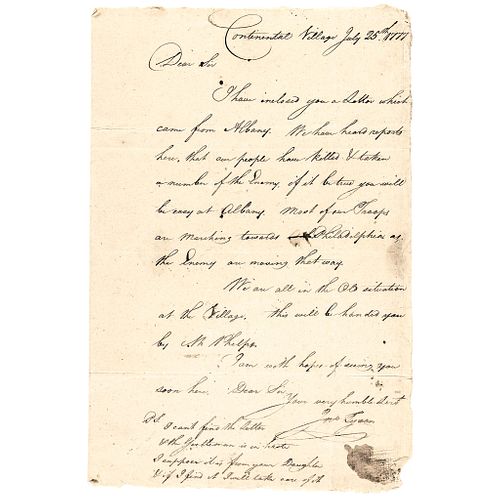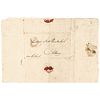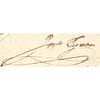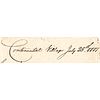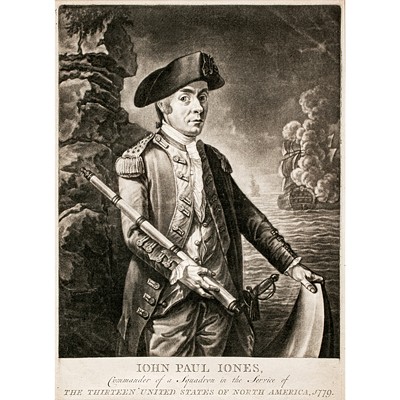American Revolutionary War Autograph Letter Signed Jonathan Tyson
Lot 87
Categories
Estimate:
$3,500 - $4,500
Absentee vs Live bid
Two ways to bid:
- Leave a max absentee bid and the platform will bid on your behalf up to your maximum bid during the live auction.
- Bid live during the auction and your bids will be submitted real-time to the auctioneer.
Bid Increments
| Price | Bid Increment |
|---|---|
| $0 | $10 |
| $200 | $20 |
| $300 | $25 |
| $500 | $50 |
| $1,000 | $100 |
| $2,000 | $200 |
| $3,000 | $250 |
| $5,000 | $500 |
| $10,000 | $1,000 |
| $20,000 | $2,000 |
| $30,000 | $2,500 |
| $50,000 | $5,000 |
| $100,000 | $10,000 |
| $200,000 | $20,000 |
| $300,000 | $25,000 |
| $500,000 | $50,000 |
About Auction
By Early American History Auctions
Jan 23, 2021
Set Reminder
2021-01-23 12:00:00
2021-01-23 12:00:00
America/New_York
Bidsquare
Bidsquare : Early American History Auction of Autographs, Americana, Political & Maps
https://www.bidsquare.com/auctions/early-american-history-auctions/early-american-history-auction-of-autographs-americana-political-maps-6311
311 Lots of Rare, Historic Autographs, Americana, Civil War Era, George Washington, Abraham Lincoln, Slavery & Black History, Revolutionary War Era, Colonial America, Federal Period, War of 1812, Colonial Currency, Indian Peace Medals & more... Early American History Auctions auctions@earlyamerican.com
311 Lots of Rare, Historic Autographs, Americana, Civil War Era, George Washington, Abraham Lincoln, Slavery & Black History, Revolutionary War Era, Colonial America, Federal Period, War of 1812, Colonial Currency, Indian Peace Medals & more... Early American History Auctions auctions@earlyamerican.com
- Lot Description
American Revolution
British General John Burgoyne to Attack Albany, New York, as General William Howe Marches on Philadelphia
July 25, 1777-Dated Revolutionary War, Autograph Letter Signed, "Jhn. Tyson" written to Major Nicholas Quackenbush, with Integral Mail Cover, Choice Extremely Fine.
An highly important Historic Revolutionary War critical military intelligence content Letter written in brown ink on fine period laid paper measuring 8" x 12". Minor paper loss at corners and some light age toning, else fine condition. This Letter was written to Major Quackenbush from Continental Village in upstate New York, near Albany. The content essentially states that the American forces were able to push back British Major General Burgoyne's army in his attempt to take Albany. This was during the British Saratoga Campaign, that ended with the "Battle of Saratoga" and the capture of Burgoyne and his army. What is interesting is that it also mentions General Howe's military campaign of 1777 known as the "Philadelphia Campaign" in his attempt to take the city of Philadelphia and capture the American Continental Congress. This military campaign ended in the famous celebrated 1778 Continental Army encampment at Valley Forge.
This important Letter is very special in content as it mentions two of the major military campaigns during the Revolutionary War. It was written during the Saratoga Campaign, just over a month before the Battle of Saratoga itself. Major Quackenbush is hereby informed that between some British being captured around Albany, and the remainder of the British troops being headed towards Philadelphia, he has a clear route to eventually engage Burgoyne at Saratoga. This important original Letter reads, in full:
"Continental Village July 25th, 1777. --- Dear Sir --- I have enclosed you a letter which came from Albany. We have heard reports here that our people have killed & taken a number of the enemy. If it be true you will be easy at Albany. Most of our troops are marching towards Philadelphia as the enemy are moving that way. We are all in the old situation at the village. This will be handed you by N. Phelps. I am with hopes of seeing you soon here. Dear sir your very humble servant Jonathan Tyson. P.S. I can't find the letter and the gentleman is in haste. I suppose it is from your daughter and if i find it I will take care of it."
Major Nicholas Quackenbush (1734-1813). Continental Army Assistant Quartermaster General (1775-1783).
A member of a powerful Dutch family in the Hudson River Valley, Nicholas Quackenbush sided with the Revolutionary cause in the 1760s through 1780s, serving as Assistant Deputy Quartermaster to the Continental forces in Albany with rank as Major.
A major trade and transport route linking British-held New York City with the Iroquois country, Canada, and to the settlements along the Mohawk River, the Hudson Rivier was a strategic keystone for both Patriot and Redcoat. It was the focus of particularly bitter contestation. From the fight for Fort Ticonderoga and invasion of Quebec at the start of the armed struggle, to Benedict Arnold's West Point plot, to the final evacuation of British troops in 1783, control of the Hudson was viewed as critical to military success.
While the position of Quartermaster may seem less than glorious, it is one of those posts on which the success of any army hangs. Concerned with the details of provisions, tents, wood for fire, shoes, and shipping, the records of the Quartermaster reveals much about the inner workings of the Continental Army as it sought to avoid destruction by their superior British foes, and about relations with the populace of upstate New York.
- Shipping Info
-
Early American provides in-house worldwide shipping. Please contact us directly if you have questions about your specific shipping requirements.
-
- Buyer's Premium



 EUR
EUR CAD
CAD AUD
AUD GBP
GBP MXN
MXN HKD
HKD CNY
CNY MYR
MYR SEK
SEK SGD
SGD CHF
CHF THB
THB